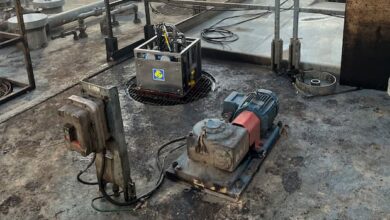New-generation shaped cutter elements expand capabilities of PDC bits to boost ROP, efficiency
Performance proven through case studies spanning Russia, Colorado’s DJ Basin, Marcellus and Colombia
By Wiley Long, Smith Bits, a Schlumberger company
Since it was introduced to the oilfield more than 40 years ago, the polycrystalline diamond compact (PDC) bit has emerged as one of the most significant step-changes in drilling tool technology. Continuing advances in the material properties and manufacturing processes used to fabricate the cutting structures of the bit have enabled the industry to tap into formations once deemed drillable only with roller cone bits, simultaneously improving average rates of penetration (ROP) by 60%.

This evolution in performance has elevated the PDC bit to a position of global dominance, giving operators the ability to expand into new frontiers, including unconventional plays using horizontal drilling techniques. In 2000, only 20% of the bits used worldwide were PDC. Today, it is the roller cone bit that accounts for just 20% of the global market. The trend is more marked in North America, where in 2018 PDC bits accounted for 89% of the market, compared with 62% in 2009.
While improvements in cutting technology have delivered a more effective tool that can drill faster and farther, less than optimal ROPs, wear and excessive bit trips that result in nonproductive time continue to pose drilling performance obstacles for PDC bits as the industry strives to maximize economics and recovery in increasingly deep and complex formations. Recognition of these challenges signaled the need for another technological step-change, specifically the development of shaped cutter elements that can more efficiently destroy rock in a variety of applications.
3D Shaped Cutting Technologies
Responding to that challenge by listening to operators, researching internal bit performance records and mining formation characterization data, Smith Bits, a Schlumberger company, five years ago introduced a portfolio of PDC bits with 3D, customizable shaped cutter geometries that are changing the way rock is destroyed in all formation types. The company’s portfolio of shaped PDC cutting elements has set global records, accumulating more than 26,000 runs and drilling more than 71 million ft (Figure 1).
The ongoing commitment to develop next-generation technologies culminated in the launch last year of the most recent portfolio addition: the HyperBlade hyperbolic diamond element bit created for application in soft and plastic formations.
While the portfolio’s shaped cutting elements are standalone technologies, they were designed to work in concert with each other and, therefore, don’t have to be run in isolation. The shaped cutting elements are engineered, manufactured, field-tested and customized in-house – a vertical integration approach that enables open discussion and free sharing of ideas to ensure the bits meet performance requirements.
The comprehensive process begins in the rock mechanics laboratory to gain an understanding of how the cutters will behave in the field when attached to a PDC bit. Cutter shapes are subjected to scrape tests in multiple types of rock samples to measure the forces necessary to push the cutters through the rock and ultimately determine how the cutter will perform in the field. For example, cutter shapes that require less vertical load to penetrate rock at a predetermined depth of cut will likely require less weight on bit to drill as part of a PDC cutting structure.
Actual fabrication of the PDC cutters is completed at the advanced ultrahard materials manufacturing facility of MegaDiamond, a Schlumberger company that works in collaboration with drill bit designers.
Once the cutting elements are field-tested, experts at the Schlumberger Customer Performance Center use the IDEAS integrated dynamic design and analysis platform to simulate formation responses in order to customize the bits. The customization process often involves making various changes to the cutting structure that can effectively impact the way the bit behaves in a specific formation or application.
Durability in High-Impact Formations
The first of the unique cutting element bits was the StingBlade conical diamond element bit, introduced in 2014, designed with impact-resistant stingers to improve PDC bit durability in hard, high-impact prone formations. In field tests of more than 10,000 runs in 55 countries, the conical diamond element bit averaged a 55% increase in footage with 30% increases in ROP compared with offset wells. In British Columbia, a StingBlade bit drilled 181% more footage compared with offsets, and in an interbedded curve application in South Texas, achieved 23% higher build rates and reduced torque.
Building on the success of the conical diamond element bit, Smith Bits in 2016 launched the AxeBlade ridged diamond element bit that combines the shearing action of a conventional PDC cutter with the crushing action of a tungsten carbide insert to improve ROP in hard, brittle formations with deeper penetration. The ridged design promotes more efficient cutting while providing better frontal impact resistance with a thicker diamond layer.
Both the ridged diamond element bit and the conical diamond element have been used in combination with high-torque motors to further improve ROP and reduce bit torque, resulting in reduced shock and vibration and improved bottomhole assembly (BHA) reliability.
Improving ROP, Directional Control
The ridged diamond bit has been deployed worldwide, including Russia, where in 2018 operator INK-Servis deployed the bit to drill a challenging 8 5/8-in. curve section through a hard carbonate formation with unconfined compressive strength (UCS) ranging from 2,000 to 25,000 psi. The well, located in the Yaraktinskoe field in Eastern Siberia, features a depth range in and out from 4,265 to 8,202 ft (1,300 to 2,500 m) with a length of about 3,280 ft (1,000 m).

Drilling starts from the shoe of a previously drilled section and continues down to a dolomite intrusion formation. In offsets, the BHA is typically pulled out of hole for bit changes.
The integrated dynamic design and analysis platform determined that the ridged diamond element bit would drill more aggressively with greater impact and wear resistance compared with conventional PDC cutters, delivering improved ROP and more stability by minimizing shock, vibration and cutter wear.
The bit achieved a 106% increase in ROP compared with the average ROP of offset wells, with ROP improving by 70% in the second run over average results seen in Q1 2017. Drilled lengths in the runs reached 1,844 ft/day (562 m/day) and 1,785 ft/day (544 m/day) respectively. The bit set six field records – three for ROP and three for daily length drilled.
Solution for Soft Formations
With the 2018 launch of the HyperBlade hyperbolic diamond element bit, the capabilities of the portfolio were enhanced, providing a solution for soft and plastic formations, characterized by high elasticity and high shale and/or clay content with exposure to hydrostatic pressures often exceeding 7,500 psi.
These conditions make the rock difficult to break under shearing loads and, ultimately, result in reduced cutting efficiency and ROP. With flat PDC cutters, cutting efficiency can be compromised due to severe bit balling as long ribbons of cuttings material pack off the bit cutting structure. The element’s hyperbolic geometry reduces this effect by creating small cuttings chips, improving cuttings removal and achieving an average ROP increase of more than 21% compared with flat PDC cutters.
The hyperbolic diamond element bit also cuts 20% deeper into the rock compared with flat cutters, while the thicker, precision-molded diamond table makes the element more durable. Additionally, the armored cutting edge can withstand formation transitions that are often encountered in low-deviation hole sections (Figure 2).
Boosting ROP in DJ Basin, Marcellus
In 2018 in Colorado’s Denver-Julesburg (DJ) Basin, a play characterized as a soft formation with low abrasion levels, a customized hyperbolic diamond element bit was equipped with backup stinger cutting elements to deliver greater impact resistance to the cutting structure and increase toughness.

In this case, the operator needed to improve ROP in the vertical section and retain steerability and build-up in the curve with enough durability to drill 10,000 to 13,000 ft of the lateral section, using one bit and one BHA.
The directional motor BHA, equipped with an 8 ½-in. hyperbolic diamond cutting element bit, achieved an average ROP increase of 20% in three wells on two separate pads in the same field. In one well, the operator saw as much as a 50% improvement in ROP in the vertical, saving 7.5 hours of drilling time, versus offset wells using conventional PDC bits. The well was the fastest drilled to TD by a specific rig in the DJ Basin (Figure 3).
In the Marcellus play, Repsol Oil and Gas USA deployed a customized hyperbolic diamond element bit with a rotary steerable system (RSS) to boost ROP in the 8 ½-in. lateral well section that is between 7,000 and 9,000 ft (2,134 m and 2,743 m). The soft formation, comprised of mostly shale with 3,000- to 5,000-psi UCS, has very low abrasion and impact properties. Repsol’s objective was to drill the section in a single run, achieving faster ROP than the baseline bit while maintaining durability.

The BHA was fitted with an 8 ½-in. bit and the PowerDrive RSS. For this application, a customized five-blade hyperbolic diamond element bit was designed to address issues associated with the drilling curve and simulate downhole bit behavior to drill the section for three wells on the same pad.
On Well 5, the BHA drilled 6,891 ft (2,100 m) in 16.6 hours, achieving an average on-bottom ROP of 415 ft/hr (126 m/hr), a record for Repsol. The application showed a 62% improvement over two offset runs with a conventional PDC bit. Overall, the three wells drilled with the hyperbolic diamond cutting element bit showed a 38% ROP improvement over two offset wells drilled with conventional PDC bits (Figure 4).
Extending PDC Bit Durability
In 2018, the EnduroBlade 360 rolling diamond element bit was enhanced with the development of a 19-mm sized rolling cutter to boost drilling performance in 12 1/4-in. vertical intervals, expanding the options from the existing 13-mm and 16-mm rolling cutters, which have been used almost exclusively in slim-hole lateral drilling applications. The diamond elements extend the cutter’s life in hard, abrasive formations with elements that rotate 360° to evenly distribute heat and wear around the circumference of the cutter.
Because of the larger size, improved materials and a precise positioning of the elements relative to contact with the formation, the new cutters have become an optimal solution for drilling with large-diameter bits in low-deviation wells. The combination of these features contributes to run length increases of up to 57%, resulting in fewer bit trips and lower drilling costs.
In 2018, Frontera Energy implemented the rolling diamond element bit to drill two sections in an exploratory campaign in Colombia’s Llanos Basin. Due to the interbedded layers of sandstone, shale and siltstone, Fronterra anticipated two runs for the 14 ¾-in. section and a borehole enlargement for the 10 5/8-by-12-in. section, subjecting the reamer blocks and the bit to the same abrasive conditions.
However, the deployment of a BHA with a single EnduroBlade 360 bit – versus standard three conventional bits used in offsets – and a PowerDrive Xceed RSS for the 14 ¾-in. section eliminated a planned run, saving $400,000. The BHA withstood 225 circulating hours, achieving an average ROP of 20 ft/hour.
For the 10 5/8-by-12-in. section, the BHA was equipped with the rolling element bit and a Rhino XC on-demand hydraulically actuated reamer along with the PowerDrive Orbit RSS. The BHA achieved 248 circulating hours with an average ROP of 15 ft/hr, reducing rig time by 2.5 days and saving $500,000. In all, the rolling diamond element bit and other technologies reduced drilling time by 12 days and saved the operator $900,000. DC




